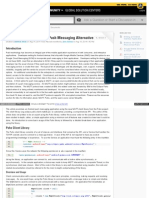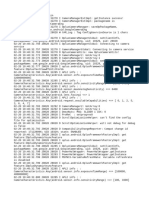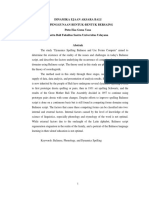2022 Paper I Model Answers Samples
2022 Paper I Model Answers Samples
Uploaded by
pradeepjoshimay8Copyright:
Available Formats
2022 Paper I Model Answers Samples
2022 Paper I Model Answers Samples
Uploaded by
pradeepjoshimay8Copyright
Available Formats
Share this document
Did you find this document useful?
Is this content inappropriate?
Copyright:
Available Formats
2022 Paper I Model Answers Samples
2022 Paper I Model Answers Samples
Uploaded by
pradeepjoshimay8Copyright:
Available Formats
HISTORY OPTIONAL
PYQ Solutions
2022 - Paper I
Q:2(a) The urban character of the Harappan Civilization was a result neither of any outside
influence nor a sudden act but a gradual evolution of regional socio-economic factors. Comment.
20
Structure:
• Introduction about the theories.
• Opinions of Scholars
• Arguments to show that urban character of the Harappan Civilization was not a result of
any outside influence.
• Arguments to show that IVC was not a sudden act.
• Conclusion
Introduction:
The origins of the Harappan civilization, also known as the Indus Valley civilization, have been the
subject of much debate among scholars. The Harappan civilization is known for its well-planned
cities, advanced sanitation systems, and unique script. While some have suggested that it was the
result of outside influence or a sudden act, others have argued that it was a gradual evolution of
regional socio-economic factors.
Theories regarding Origin:
John Marshall:
• In his report on Mohenjodaro, John Marshall asserted that the Indus civilization must have
had a long antecedent history on the soil of India. However, there were others who put
forward diffusionist explanations.
E. J. H. Mackay:
• According to E. J. H. Mackay, a migration of people from Sumer (southern Mesopotamia)
may have led to the Harappan civilization;
• other proponents of the migration theory included D. H. Gordon and S. N. Kramer
Mortimer Wheeler:
DIADEMY IAS, DELHI 9811599537 1
• Mortimer Wheeler argued for a migration of ideas, not people-the idea of civilization was in
the air of West Asia in the 3rd millennium BCE and the founders of the Harappan civilization
had a model of civilization before them.
Differences between Mesopotamians and Harappans:
• The fact that city life emerged in Mesopotamia a few centuries before it appeared in the
Egyptian and Harappan contexts does not mean that the latter were derived from the
former in a direct or indirect way.
• There are in fact several striking differences between the Harappan and Mesopotamian
civilizations.
o The Mesopotamians had a completely different script,
o a much greater use of bronze,
o different settlement layouts, and
o a large-scale canal system of the kind that seems absent in the Harappan civilization.
Therefore, Harappans are not migrants from Mesopotamia. Of course, there might have been
influence in the civilization but it is not evident to say that the authors of Indus Valley were
outsiders.
Real factors behind the Origin:
• The story of its origins can, in fact, be traced to the emergence of settled farming
communities in Baluchistan in the 7th millennium BCE.
• Its more immediate prelude was the cultural phase that used to be known as pre-Harappan,
and is now usually referred to as the early Harappan phase.
Not a sudden act but a gradual process:
Amalananda Ghosh (1965):
• Amalananda Ghosh (1965) was the first archaeologist to identify similarities between a pre-
Harappan culture and the mature Harappan culture.
• Ghosh focused on the pre-Harappan Sothi culture of Rajasthan. He asserted that there were
similarities between Sothi pottery and the pottery of
o (a) Zhob, Quetta, and other Baluchi sites;
o (b) pre-Harappan Kalibangan, Kot Diji, and the lowest levels of Harappa and
Mohenjodaro; and
o (c) mature Harappan levels at Kalibangan, and perhaps also at Kot Diji.
DIADEMY IAS, DELHI 9811599537 2
In view of these similarities, he argued that the Sothi culture should be described as proto-
Harappan.
Limitation of this Hypothesis: A limitation of this hypothesis was that it was based exclusively on a
comparison of pottery, and did not consider other material traits. And in emphasizing ceramic
similarities, Ghosh had ignored the many differences between the Sothi and Harappan cultures. The
result was an over-emphasis on the Sothi element in the account of the emergence of the Harappan
civilization.
M.R. Mughal:
• M.R. Mughal made the first comprehensive analysis of pre-Harappan sites in the greater
Indus valley and north Baluchistan in 1977. He compared the evidence from pre-Harappan
and mature Harappan levels and found that the pre-Harappan phase showed large fortified
settlements, specialized crafts, trade networks, and the use of wheeled transport.
• However, the pre-Harappan phase lacked large cities and increased levels of craft
specialization compared to the mature Harappan phase.
• Mughal argued that the term 'pre-Harappan' should be replaced with 'early Harappan' since
the former represents the early, formative phase of the Harappan culture.
• Several early Harappan sites have been identified, including Balakot, Nal, Amri, Kot Diji,
Mehrgarh, Nausharo, Gumla, and Rehman Dheri.
Conclusion:
In conclusion, the urban character of the Harappan civilization was not the result of any outside
influence or sudden act but a gradual evolution of regional socio-economic factors. The emergence
of settled farming communities in Baluchistan in the 7th millennium BCE and the subsequent early
Harappan phase laid the foundation for the development of the mature.
DIADEMY IAS, DELHI 9811599537 3
Q:2(b) Foreign accounts as a source of ancient Indian history may have some advantages but also
have a few shortcomings. Citing appropriate examples, examine the statement. 15
Structure:
• Introduction about the importance of foreign accounts.
• Highlight the Positives of the foreign accounts
• Highlight the limitations of the foreign accounts
• Give a balanced Conclusion
Introduction:
Foreign accounts provide valuable insight into the history of ancient India. These accounts were
written by foreign ambassadors, travellers, pilgrims, soldiers, settlers, traders, and thinkers who
visited or lived in India at various times in history. These accounts have both advantages and
shortcomings.
Advantages:
• Foreign accounts provide a different perspective on Indian history, providing a glimpse of
how Indians were viewed by people from other lands and cultures.
• They provide valuable information about Indian society, economy, religion, culture, and
politics from a non-Indian viewpoint.
• These accounts serve as a supplement to Indian historical sources, filling in gaps and
providing new information about Indian history.
• They often provide information about regions, people, or events that are not mentioned in
Indian sources.
• They can also offer new interpretations of Indian historical events or trends, based on the
observations and analysis of foreign writers.
Greeco-Roman Sources:
• Indica of Megasthenes, ambassador of Seleucus Nikator to the court of Chandragupta
Maurya is an important source of Mauryan Period. The book is lost, but later Greek works
preserve paraphrases of some of its sections.
• The many Greek and Latin texts of the 2nd century BCE to the 2nd century CE referring to
India include the works of Arrian, Strabo, and Pliny the Elder, and the anonymous Periplus
of the Erythraean Sea. These texts are especially important for the history of Indian Ocean
trade.
Chinese Sources:
DIADEMY IAS, DELHI 9811599537 4
• The best known among those who wrote accounts of their Indian travels are Faxian (Fa Hien)
and Xuanzang (Hiuen Tsang).
• Faxians travels extended from 399 to 414 CE and were confined to northern India.
• Tsuan Tsang left his home in 629 CE and spent over 10 years travelling the length and
breadth of the country.
• I-tsing, another 7th century Chinese traveller, lived for 10 years in the great monastery of
Nalanda. The accounts written by these pilgrims throw light on the history of Buddhism and
various other aspects of their time.
Arabic and Persian Sources:
• The anonymous Chachnama describes how a Brahmana named Chach usurped the throne
of Sindh in the mid-7th century and narrates the Arab conquest of that region by
Muhammad bin Qasim.
• Several Arabic geographical and travel accounts were written in the early medieval period.
Some of these, such as the account of the traveller Sulaiman, refer to India. This is not
surprising considering that both Arabs and Indians were actively involved in Indian Ocean
trade. Such works throw light on trade and aspects of Indian political history. Persian was
the language of royal courts and high culture in central and West Asia in early medieval
times, and a number of Persian texts refer to India.
• The Shahnama of Firdausi, a classic of Persian poetry, and the Gulistan by the famous poet
Saadi, refer incidentally to aspects of Indian trade.
• Al-Biruni travelled to India to satisfy his curiosity about the land and its people, and to study
their ancient texts in their original language. His Tarikh-i-Hind covers a large number of
topics including Indian scripts, sciences, geography, astronomy, astrology, philosophy,
literature, beliefs, customs, religions, festivals, rituals, social organization, and laws. Apart
from the historical value of his descriptions of 11th century India, Al-Biruni helped modem
historians identify the initial year of the Gupta era.
Shortcomings:
Accuracy is questionable:
• The accuracy of some foreign accounts is questionable, as they may contain hearsay or
misinformation, especially if the writer had limited personal experience in India. An example
of a very unreliable account is the Indica of Ktesias (4th century BEE), which is full of bizarre
DIADEMY IAS, DELHI 9811599537 5
stories about India and Indians, collected by the author while living in Persia as a royal
physician.
• Foreign accounts may also be biased, reflecting the writer's cultural or national prejudices.
• They may have misinterpreted Indian customs or beliefs, leading to misunderstandings or
incorrect assumptions.
• Foreign accounts may be selective, highlighting only what the writer considered important
or interesting, rather than providing a comprehensive picture of Indian society or history.
• Finally, some foreign accounts may have been written for political or religious reasons, and
may not represent an accurate portrayal of Indian society or history.
Conclusion:
In conclusion, while foreign accounts of ancient Indian history provide valuable insight into the
country's past, historians must evaluate them carefully, taking into account their potential biases,
limitations, and inaccuracies. By examining these accounts alongside Indian sources, historians can
develop a more complete and nuanced understanding of Indian history.
DIADEMY IAS, DELHI 9811599537 6
You might also like
- G6 Reading ComprehensionDocument51 pagesG6 Reading ComprehensionViệt Đức100% (22)
- The India They SawDocument676 pagesThe India They SawSupratik Sarkar67% (3)
- DLP Incident Handling SOPDocument19 pagesDLP Incident Handling SOPsivapavani4245No ratings yet
- Sources of Ancient Indian HistoryDocument5 pagesSources of Ancient Indian HistoryRamita Udayashankar100% (7)
- HarappaDocument28 pagesHarappaShubham Trivedi92% (13)
- Ancient Lecture 12Document23 pagesAncient Lecture 12pooja sinhaNo ratings yet
- Exclusive Sample Copy of Notes 2.0Document49 pagesExclusive Sample Copy of Notes 2.0SparksNo ratings yet
- 315 History Eng Lesson3Document18 pages315 History Eng Lesson395astonmartinNo ratings yet
- History Project (Harappan and Mesopotamian Civilizations)Document13 pagesHistory Project (Harappan and Mesopotamian Civilizations)radhika242008No ratings yet
- Origins of HarappaDocument4 pagesOrigins of HarappaSandhya BossNo ratings yet
- Indus Vally CivilisationDocument5 pagesIndus Vally CivilisationPreet GonsalvesNo ratings yet
- History Optional Strategy by Nidhi Siwach 1Document94 pagesHistory Optional Strategy by Nidhi Siwach 1sachinNo ratings yet
- SourcesDocument9 pagesSourcesChhaviNo ratings yet
- Chapter 3Document4 pagesChapter 3astrovastuexpertbalramNo ratings yet
- Histroy of Indus Valley Civilizaton 55Document25 pagesHistroy of Indus Valley Civilizaton 55Wasil AliNo ratings yet
- Ancient History 04 - Daily Class Notes - UPSC Sankalp 3.0 (Hinglish)Document4 pagesAncient History 04 - Daily Class Notes - UPSC Sankalp 3.0 (Hinglish)jakatiupdateclassesNo ratings yet
- The Harappan Civilization - IDocument35 pagesThe Harappan Civilization - IMegha khannaNo ratings yet
- Medieval History New NCERT Notes - Class 12: Team Shashank Sajwan Theme 5 - Through The Eyes of TravellersDocument22 pagesMedieval History New NCERT Notes - Class 12: Team Shashank Sajwan Theme 5 - Through The Eyes of Travellerspranamsonavane2003No ratings yet
- Indus Vally CivilisationDocument6 pagesIndus Vally CivilisationPreet GonsalvesNo ratings yet
- 1457346187ET05Document9 pages1457346187ET05chaharaman081No ratings yet
- History Book L03Document18 pagesHistory Book L03ajawaniNo ratings yet
- IBR New Curriculum Grade 7 BDDocument63 pagesIBR New Curriculum Grade 7 BDmun25banglaNo ratings yet
- 1689403192-History Mains Test 3 Answer SheetDocument20 pages1689403192-History Mains Test 3 Answer Sheetskpanchal345No ratings yet
- Study of The Indus Script PDFDocument39 pagesStudy of The Indus Script PDFparthibanmaniNo ratings yet
- The Harappan Civilization PDFDocument58 pagesThe Harappan Civilization PDFShreyashi KashyapNo ratings yet
- H 3Document13 pagesH 3Shubhanjali KushwahaNo ratings yet
- Chapter 2 Harappan CivilizationDocument24 pagesChapter 2 Harappan CivilizationlalitNo ratings yet
- Themes in Indian History-Part-II Class XIIDocument30 pagesThemes in Indian History-Part-II Class XIIDefence BratNo ratings yet
- Ancient Civilization of South AsiaDocument13 pagesAncient Civilization of South Asiadreamcatcher4801No ratings yet
- The History Compendium - Disha Publication PDFDocument268 pagesThe History Compendium - Disha Publication PDFDinesh kumar TrivediNo ratings yet
- Foreign Accounts: Greek, Chinese and Arab Writers: Part I - Self Study HistoryDocument3 pagesForeign Accounts: Greek, Chinese and Arab Writers: Part I - Self Study Historykanak singhNo ratings yet
- Chinese (Yellow River) - All These Bronze Age Civilizations Had Different Technological LevelsDocument17 pagesChinese (Yellow River) - All These Bronze Age Civilizations Had Different Technological LevelsbastobdasNo ratings yet
- Hand Gestures From RvpuramDocument46 pagesHand Gestures From RvpuramadeeshmidasNo ratings yet
- The Harappan Civilization NotesDocument15 pagesThe Harappan Civilization Notesishikachauhan.bah.2023.ipcwNo ratings yet
- History IDocument41 pagesHistory Imdsaqibansari.ballbNo ratings yet
- Ancient Lecture 15Document15 pagesAncient Lecture 15pooja sinhaNo ratings yet
- The Harappan CivilizationDocument56 pagesThe Harappan CivilizationAñkañ MõndálNo ratings yet
- BENG261 (Harappan Civilization)Document13 pagesBENG261 (Harappan Civilization)TANYA KASHYAP 2133170No ratings yet
- 1 Ancient IndiaDocument117 pages1 Ancient IndiaRajat KumarNo ratings yet
- Table of ContentsDocument13 pagesTable of Contentskhansheeza367No ratings yet
- TIMELINE - An Analysis of INDUS VALLEY Civilization Evidences, Findings and PapersDocument11 pagesTIMELINE - An Analysis of INDUS VALLEY Civilization Evidences, Findings and PapersSamrat ChatterjeeNo ratings yet
- Name Origin of The Indus CivilizationDocument10 pagesName Origin of The Indus CivilizationYaar Jigree Season 3No ratings yet
- History-Harappan CivilizationDocument9 pagesHistory-Harappan Civilizationbhasmakar5971No ratings yet
- What Were The Major Achievements of The Egyptians? How Did They Influence Later Societies?Document10 pagesWhat Were The Major Achievements of The Egyptians? How Did They Influence Later Societies?Tonnie KiamaNo ratings yet
- Indus Valley CivilisationDocument51 pagesIndus Valley Civilisationplast_adesh100% (1)
- The Gupta EmpireDocument25 pagesThe Gupta Empireparijat_96427211100% (2)
- Indian Church HistoryDocument59 pagesIndian Church HistoryKyaw thant zinNo ratings yet
- 25NCERT Class 12 History Part 2 PDFDocument146 pages25NCERT Class 12 History Part 2 PDFNaser_Ahmed11No ratings yet
- History AssignmentDocument19 pagesHistory Assignmentkhansheeza367No ratings yet
- Ancient IndiaDocument72 pagesAncient IndiaReena MpsinghNo ratings yet
- History Chapter 1Document6 pagesHistory Chapter 1Vineet KhuranaNo ratings yet
- NCERT Book Themes in Indian History Part II Class XIIDocument111 pagesNCERT Book Themes in Indian History Part II Class XIInikhilam.com50% (4)
- Themes in India 2Document145 pagesThemes in India 2சுப.தமிழினியன்No ratings yet
- The Rise and Fall of Khoqand, 1709-1876: Central Asia in the Global AgeFrom EverandThe Rise and Fall of Khoqand, 1709-1876: Central Asia in the Global AgeNo ratings yet
- A Short History of India: From the Earliest Civilisations and Myriad Kingdoms, to Today's Economic PowerhouseFrom EverandA Short History of India: From the Earliest Civilisations and Myriad Kingdoms, to Today's Economic PowerhouseRating: 3 out of 5 stars3/5 (2)
- History of India from the Earliest Times to the Sixth Century B.C.From EverandHistory of India from the Earliest Times to the Sixth Century B.C.No ratings yet
- Ancient India for Kids - Early Civilization and History | Ancient History for Kids | 6th Grade Social StudiesFrom EverandAncient India for Kids - Early Civilization and History | Ancient History for Kids | 6th Grade Social StudiesNo ratings yet
- Imperial Connections: India in the Indian Ocean Arena, 1860-1920From EverandImperial Connections: India in the Indian Ocean Arena, 1860-1920No ratings yet
- Introducing SQLite.Document1 pageIntroducing SQLite.hiren waghelaNo ratings yet
- Assembly Language Programming Building MicrocomputerDocument32 pagesAssembly Language Programming Building MicrocomputerbavariankingNo ratings yet
- Moot VS Snacks IM LogsDocument20 pagesMoot VS Snacks IM LogsIchitsukiNo ratings yet
- Teaching English As A Foreign Language TEFLDocument72 pagesTeaching English As A Foreign Language TEFLJonerlyn TaboraNo ratings yet
- Lab Work 1Document2 pagesLab Work 1Adly HakimNo ratings yet
- Microwave Distance Sensor DatasheetDocument7 pagesMicrowave Distance Sensor DatasheetJorge FarinhaNo ratings yet
- Developer Motorola Solutions DOC 2315Document21 pagesDeveloper Motorola Solutions DOC 2315Achmad MustofaNo ratings yet
- Kompetisi Pelajar Nasional English SMADocument12 pagesKompetisi Pelajar Nasional English SMAFebriyanti ZubaidiNo ratings yet
- B - 11 - Vaishnavi Gangshettiwar - Project ReportDocument29 pagesB - 11 - Vaishnavi Gangshettiwar - Project ReportSubhAsh Birajdar SBNo ratings yet
- Create Your Own HistoryDocument1 pageCreate Your Own Historyshiela mae ucangNo ratings yet
- Meet The Teacher 1Document1 pageMeet The Teacher 1api-509584346No ratings yet
- R18 COs - 2Document3 pagesR18 COs - 2cholleti sriramNo ratings yet
- SupplicationsDocument5 pagesSupplicationsMohammad Faisal SaleemNo ratings yet
- PDF. English. Unit 2Document10 pagesPDF. English. Unit 2JOSE LUIS POLOP LLORNo ratings yet
- Alabama Affixes and Important WordsDocument28 pagesAlabama Affixes and Important Wordsalibamu montlerNo ratings yet
- Connecting HTML Help To Visual Basic Programs: by Don LammersDocument15 pagesConnecting HTML Help To Visual Basic Programs: by Don Lammersudahjadi100% (2)
- Application Help BPC MSDocument86 pagesApplication Help BPC MSrkNo ratings yet
- Jungle CocekDocument3 pagesJungle Cocekyarin ohayonNo ratings yet
- NI Tutorial 2835 enDocument14 pagesNI Tutorial 2835 enurielNo ratings yet
- Final Adv5Document5 pagesFinal Adv5Jacqui AguilarNo ratings yet
- POSTMODERNISMDocument31 pagesPOSTMODERNISMmuhammad haris100% (3)
- Logcat 1676864432725Document59 pagesLogcat 1676864432725Leo GurlsNo ratings yet
- Doing PhilosophyDocument72 pagesDoing PhilosophyClarence ImperialNo ratings yet
- The History of The Study of Language DevelopmentDocument9 pagesThe History of The Study of Language DevelopmentNo NoyNo ratings yet
- THE Chat GPT GuideDocument23 pagesTHE Chat GPT GuideApple ID Config89% (9)
- Understanding The SelfDocument4 pagesUnderstanding The Selfscarlette.ivy.0892No ratings yet
- 1 Irfan AhmadDocument2 pages1 Irfan AhmadJilani ShaikNo ratings yet
- Dinamika Ejaan Aksara Bali Dan Penggunaan Bentuk-Bentuk Bersaing Putu Eka Guna Yasa Sastra Bali Fakultas Sastra Universitas UdayanaDocument10 pagesDinamika Ejaan Aksara Bali Dan Penggunaan Bentuk-Bentuk Bersaing Putu Eka Guna Yasa Sastra Bali Fakultas Sastra Universitas Udayanarico rubenNo ratings yet

























































































